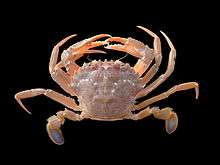Portunidae
Portunidae is a family of crabs which contains the swimming crabs.
| Portunidae | |
|---|---|
 | |
| Liocarcinus depurator | |
| Scientific classification | |
| Kingdom: | |
| Phylum: | |
| Subphylum: | |
| Class: | |
| Order: | |
| Infraorder: | |
| Superfamily: | |
| Family: | Portunidae Rafinesque, 1815 [1] |
| Subfamilies | |
| |
Description
Portunid crabs are characterised by the flattening of the fifth pair of legs into broad paddles, which are used for swimming.[2] This ability, together with their strong, sharp claws, allows many species to be fast and aggressive predators.[2]
Examples
Its members include many well-known shoreline crabs, such as the European shore crab (Carcinus maenas), blue crab (Callinectes sapidus), velvet crab (Necora puber) and lady crab (Ovalipes ocellatus). Two genera in the family are contrastingly named Scylla and Charybdis; the former contains the economically important species black crab (Scylla serrata) and Scylla paramamosain.
Taxonomy
The circumscription of the family varies, with some authors treating "Carcinidae", "Catoptridae" and "Macropipidae" as separate families,[1] and others considering them subfamilies of a wider Portunidae.[3] Swimming crabs reach their greatest species diversity in the Pacific and Indian Oceans.[4]
Extinct genera are marked with an obelisk.
- Caphyrinae Guérin, 1832
- Caphyra Guérin, 1832
- Coelocarcinus Edmondson, 1930
- Lissocarcinus Adams & White, 1849
- Mioxaiva † Müller, 1978
- Carcininae MacLeay, 1838
- Carcinus Leach, 1814
- Cicarnus † Karasawa & Fudouji, 2000
- Miopipus † Müller, 1984
- Portumnus Leach, 1814
- Xaiva MacLeay, 1838
- Carupinae Paul’son, 1875
- Carupa Dana, 1851
- Catoptrus A. Milne-Edwards, 1870
- Libystes A. Milne-Edwards, 1867
- Neptocarcinus † Lőrenthey, 1898
- Rakosia † Müller, 1984
- Richerellus Manning & Felder, 1989
- Podophthalminae Dana, 1851
- Euphylax Stimpson, 1860
- Podophthalmus Lamarck, 1801
- Psygmophthalmus † Schweitzer, Iturralde-Vinent, Hetler & Velez-Juarbe, 2006
- Sandomingia † Rathbun, 1919
- Saratunus † Collins, Lee & Noad, 2003
- Viaophthalmus † Karasawa, Schweitzer & Feldmann, 2008
- Polybiinae Ortmann, 1893
- Bathynectes Stimpson, 1871
- Benthochascon Alcock & Anderson, 1899
- Boschettia † Busulini, Tessier, Beschin & De Angeli, 2003
- Brusinia Števčić, 1991
- Coenophthalmus A. Milne-Edwards, 1879
- Falsiportunites † Collins & Jakobsen, 2003
- Gecchelicarcinus † Beschin, Busulini, De Angeli & Tessier, 2007
- Liocarcinus Stimpson, 1871
- Macropipus Prestandrea, 1833
- Maeandricampus † Schweitzer & Feldmann, 2002
- Megokkos † Schweitzer & Feldmann, 2000
- Minohellenus † Karasawa, 1990
- Necora Holthuis, 1987
- Ophthalmoplax † Rathbun, 1935
- Parathranites Miers, 1886
- Pleolobites † Remy, 1960
- Polybius Leach, 1820
- Pororaria † Glaessner, 1980
- Portufuria † Collins, Schulz & Jakobsen, 2005
- Portunites † Bell, 1858
- Proterocarcinus † Feldmann, Casadío, Chirino-Gálvez & Aguirre-Urreta, 1995
- Raymanninus Ng, 2000
- Rhachiosoma † Woodward, 1871
- Portuninae Rafinesque, 1815
- Acanthoportunus † Schweitzer & Feldmann, 2002
- Arenaeus Dana, 1851
- Atoportunus Ng & Takeda, 2003
- Callinectes Stimpson, 1860
- Carupella Lenz in Lenz & Strunck, 1914
- Colneptunus † Lőrenthey in Lőrenthey & Beurlen, 1929
- Cronius Stimpson, 1860
- Euronectes † Karasawa, Schweitzer & Feldmann, 2008
- Laleonectes Manning & Chace, 1990
- Lupella Rathbun, 1897
- Lupocyclus Adams & White, 1849
- Necronectes † A. Milne-Edwards, 1881
- Portunus Weber, 1795
- Pseudoachelous † Portell & Collins, 2004
- Rathbunella † Collins in Collins, Portell & Donovan, 2009
- Sanquerus Manning, 1989
- Scylla De Haan, 1833
- Thalamitinae Paul’son, 1875
- Charybdis De Haan, 1833
- Eocharybdis † Beschin, Busulini, De Angeli & Tessier, 2002
- Gonioinfradens Leene, 1938
- Thalamita Latreille, 1829
- Thalamitoides A. Milne-Edwards, 1869
- Enoplonotus † A. Milne-Edwards, 1860
- Neptunus † de Haan 1839
References
- Sammy De Grave; N. Dean Pentcheff; Shane T. Ahyong; et al. (2009). "A classification of living and fossil genera of decapod crustaceans" (PDF). Raffles Bulletin of Zoology. Suppl. 21: 1–109.
- P. J. F. Davie (2002). "Portunidae". Crustacea: Malocostraca: Eucarida (Part 2), Decapoda: Anomura, Brachyura. Volume 19 of Zoological catalogue of Australia, Australia. CSIRO Publishing. pp. 442–446. ISBN 978-0-643-05677-0.
- Peter K. L. Ng, Danièle Guinot & Peter J. F. Davie (2008). "Systema Brachyurorum: Part I. An annotated checklist of extant Brachyuran crabs of the world" (PDF). Raffles Bulletin of Zoology. 17: 1–286.
- "WoRMS taxon details, Ovalipidae Spiridonov, Neretina & Schepetov, 2014". World Register of Marine Species. 2019. doi:10.14284/170. Retrieved 2019-12-29.
External links

